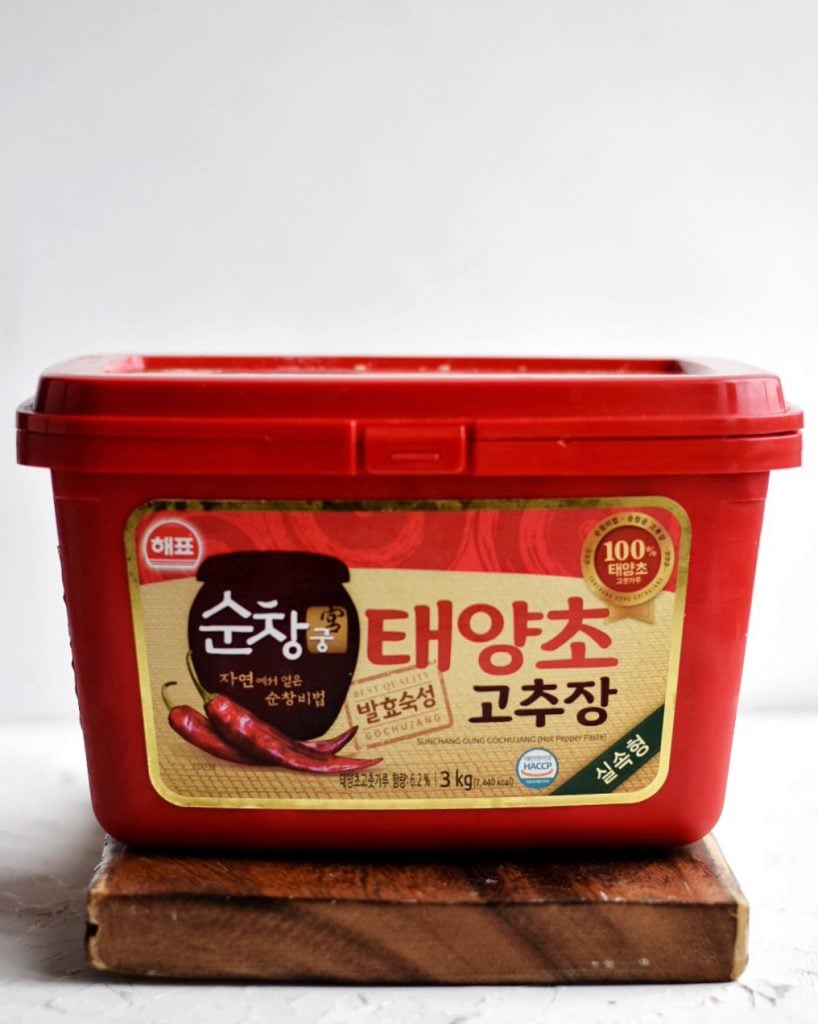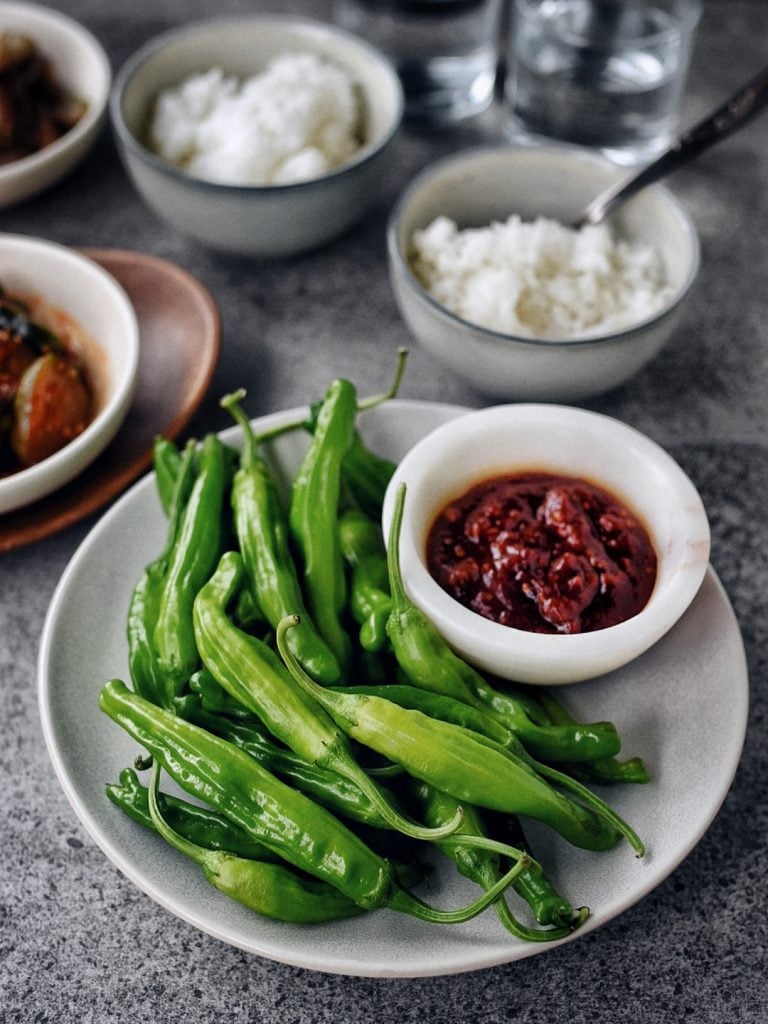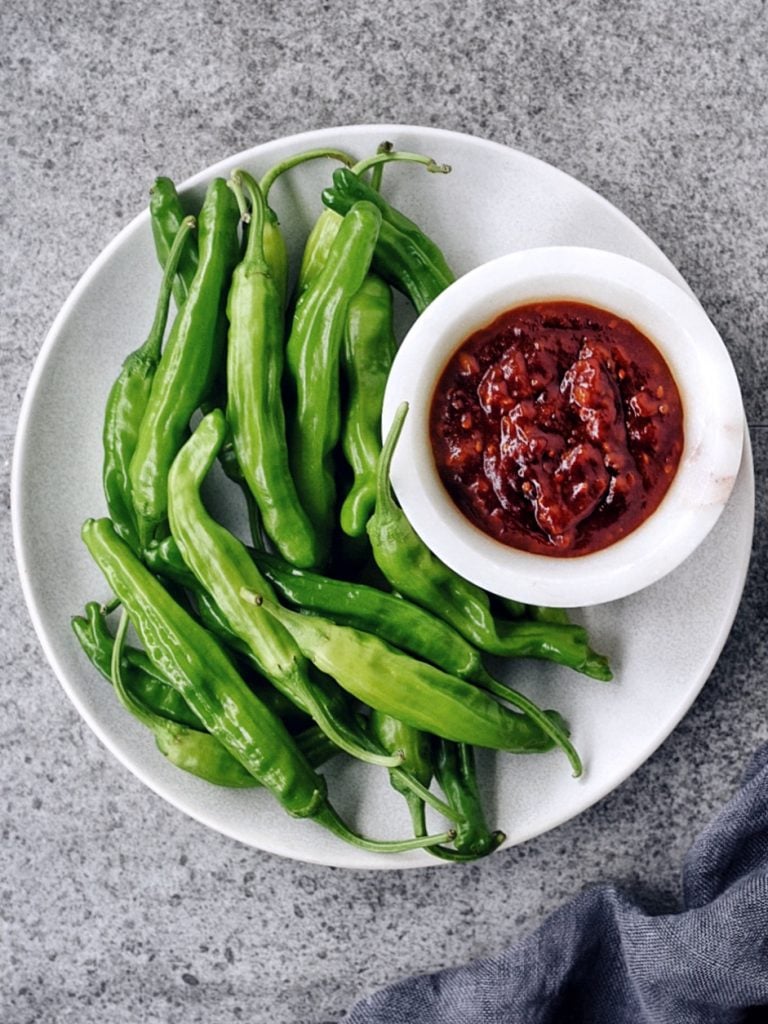Make a 5-minute Korean Sauce: Gochujang Sauce! Also known as Bibimbap Sauce, this spicy sauce goes with everything and is made with simple ingredients. Serve as a dipping sauce with raw veggies. Or drizzle all over rice bowls with a fried egg on top. Easy to make and gives everything a spicy kick!
What is Gochujang Sauce?
Gochujang Sauce is a bright red, spicy condiment used in Korean cuisine. If you’ve eaten at a Korean restaurant, you’ve probably seen a tall plastic squeezie bottle at the table. That’s Gochujang Sauce. Spicy, tangy, and slightly sweet — this popular Korean condiment is drizzled on top of pretty much anything.
In Korean, Gochujang Sauce is called Cho Gochujang. “Cho” means vinegar. It is added to raw Gochujang to make it into a sauce. The vinegar makes it tangy, smooth, and pourable.
Gochujang Sauce is unique because it has a spicy flavor that is also sweet with lots of umami. Different from other hot sauces, it is vibrantly flavored — the perfect balance of tangy, spicy-sweet, and also savory.
The main ingredient of Gochujang Sauce is Gochujang — Korean chili paste. Dried red chili peppers are mixed into a thick paste with salt, soybeans, glutinous rice, corn syrup, and dried red chili powder. The process of fermentation deepens the bold flavors of the red pepper paste into something truly special.

How do you eat Gochujang Sauce?
There are many ways to eat Gochujang Sauce. Think of it as a condiment like ketchup or sriracha. It goes with everything!
The most popular way is with Bibimbap or rice bowls. Drizzle over any rice dish and mix. YUM.
In a Korean home, it’s used as a dip for veggies such as cucumber, tomatoes, and shishito peppers. It also makes a great dipping sauce for meat and protein — boiled chicken, shrimp cocktail, and squid, etc.
Nowadays, Gochujang goes with anything that needs a kick of spice. Drizzle this flavorful sauce on top of scrambled eggs, avocado toast, french fries, nachos, hashbrowns, pizza, tacos — everything! You can even buy squeeze bottles of Cho Gochujang at Korean markets.
Ingredients:
- Gochujang (affiliate). Korean fermented chili paste. Bright red with a thick, pasty texture, the flavor is spicy-sweet, savory, and little smoky.
Look for Gochujang at Korean Grocery Stores. Korean red pepper paste can also be found in the international food aisles at regular grocery stores. Make sure to read the label as Gochujang can have a spicy level, ranging fron 1-5.
- Vinegar. Essential for that bright and tangy flavor. Also to make it smooth and pourable. I alternate between Rice Vinegar and Apple Vinegar. The Rice Vinegar is more acidic and tangy. The Apple Vinegar is more fruity and floral. Also, white vinegar works fine if you don’t have either.
- Sugar. Sweetness rounds out all the intense flavors. Regular white granulated sugar works great. Can be swapped with maple syrup or honey.
- Soy Sauce. Add more umami richness with a little bit of soy sauce. Note: do not use low-sodium soy sauce! I find it leaves behind a weird metallic taste.
- Sesame Oil. Makes Gochujang Sauce smooth and pourable. Also adds an aromatic fragrance and a unique, nutty flavor.


How to make Bibimbap Sauce:
- Mix. Add ingredients to a medium bowl and mix until smooth and runny.
- Serve. Pour, drizzle, and dip this versatile sauce onto everything!
Serve with:
- Bibimbap – Drizzle all over Bibimbap or your favorite rice bowl. A fried runny egg on top is a must!
- Korean BBQ – Use as a sauce for grilled meats. Swipe onto lettuce wraps, like Ssamjang.
- Raw veggies – Serve with raw veggies like cucumbers, tomatoes, carrots, shishito peppers, lightly steamed broccoli or cauliflower, etc. I grew up eating vegetables this way in my Korean American home.
- Seafood. Cho Gochujang tastes great with shrimp cocktail, boiled squid, and lobster. Serve in place of cocktail sauce.
- Salad. Commonly used as salad dressings for Hwe Dup Bap or Bibimbap with a base of salad. Drizzle on top of any greens with a bowl of rice.

Variations:
- Add garlic. Add 2 minced garlic cloves for a deep, garlic flavor.
- Add sesame seeds. Add 1 Tbsp sesame seeds for a thicker texture and nutty flavor.
How to store:
Leftover sauce keeps well in an airtight container in the fridge for 2-3 weeks. Make sure it’s tightly covered so it doesn’t dry out.
- Glass Jar. Find a jar with a tight-fitting lid. Store in the coldest part of the fridge. When ready to use, remove from the fridge and stir. If it’s too thick, add more sesame oil to make it runny and pourable. If the flavor is flat, add a little more vinegar.
- Squeeze bottle. Double the recipe and add to a squeeze bottle. Make sure the tip is tightly covered. Shake before drizzling!
FAQ:
Gochujang Sauce is similar to Sriracha because they are both spicy. But they are not the same. The flavor is quite different. Gochujang Sauce is also thicker and more saucy.
To find out if your brand of Gochujang is gluten-free, look at the ingredient list. Every brand differs. Some will contain small amounts of wheat flour or malt barley, which contain gluten.
Gochujang is an essential ingredient in Korean cooking. A scoop of raw Gochujang can be added to make soups, stews, fried rice, tteokbokki, Spicy Chicken Rice Bowls, and meat dishes like Gochujang Chicken. Look at the list below for more inspiration.

More recipes with Gochujang:
- Gochujang Jjigae (Tofu Soup)
- Spicy Gochujang Chicken Thighs
- Gochujang Ground Pork Rice Bowls
- Slow Cooker BBQ Gochujang Pulled Pork
- Roasted Gochujang Chicken Drumsticks
More sauces and condiments:

Easy Korean Gochujang Sauce (Bibimbap Sauce)
Ingredients
- 1/4 cup Gochujang Korean fermented chili paste
- 2 Tbsp rice vinegar (white vinegar also works)
- 1 Tbsp sugar (honey or maple syrup also work)
- 1 Tbsp soy sauce
- 2 Tbsp sesame oil
- 1 tsp sesame seeds *optional (don't add if storing in a squeeze bottle)
Instructions
Notes
- Gochujang Sauce keeps well in an airtight container in the fridge for 2-3 weeks. Make sure it’s tightly covered so it doesn’t dry out. Two ways to store:
-
- Glass Jar. Store in the coldest part of the fridge. When ready to use, remove from the fridge and stir. If it’s too thick, add more sesame oil to make it runny and pourable. If the flavor is flat, add a little more vinegar.
- Squeeze bottle. Double the recipe and add to a squeeze bottle. Make sure the tip is tightly covered.

Would this be good as a stir fry sauce? Rice, chicken, veggies?
I’ve never tried it as a stir fry sauce, as it will probably easily burn (gochujang burns easily). But you could drizzle all over a rice bowl and mix it up while it’s hot. Or drizzle over chicken that’s been already cooked. Enjoy!
This is my new favourite sauce, so good!
Pingback: My North Korean Grandmother's Braised Pork Belly | The Subversive Table
Tasted great. Added fresh green onion and a little hoison (wife it a little spicy).